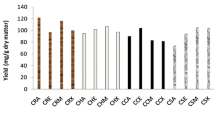Abstract
Different polar solvents (methanol, acetone and water) were tested for their extractability of phenolic compounds from millets grown in India namely, sawan (Echinochloa frumentacea), kodo (Paspalum scrobiculatum), jowar (Sorghum bicolor) and bajra (Pannisetum typhoides). The extracts were evaluated for their total phenolics, flavonoids, ascorbic acid content and antioxidant activity. The acetone extracts reported highest total phenolics content (TPC) between 0.8 and 2.64 mg gallic acid equivalents/g flour dry matter; the lowest for sawan and the highest for bajra. Ascorbic acid content did not differ significantly between different millets (p < 0.05) except for sawan (lowest). The antioxidant assays included 1,1-diphenyl-2-picrylhydrazyl (DPPH), hydroxyl radical (OH*) scavenging and reducing power. The activity in millets followed as bajra > jowar > kodo > sawan. The polyphenols in extracts were also analyzed by high-performance liquid chromatography (HPLC) at 290 nm. A clear correlation obtained between the TPC, flavonoids content and antioxidant activity. Acetone showed better extractability and thus can be appropriate solvent to extract phenolic compounds in millets used in this study.


Similar content being viewed by others
References
Barros L, Falcao S, Baptista P, Freire C, Vilas-Boas M, Ferreira ICFR (2008) Antioxidant activity of Agaricus sp. mushrooms by chemical, biochemical and electrochemical assays. Food Chem 111:61–66
Brand-Williams W, Cuvelier ME, Berset C (1995) Use of a free radical method to evaluate antioxidant activity. LWT-Food Sci Technol 28(1):25–30
Bravo L (1998) Polyphenols: chemistry, dietary sources, metabolism and nutritional significance. Nutr Rev 56:317–333
Hadimani NA, Malleshi NG (1993) Studies on milling, physico-chemical properties, nutrient composition and dietary fibre content of millets. J Food Sci Technol 30:17–20
Halliwell B, Gutteridge JMC, Aruoma OI (1987) Deoxyribose method: a simple “test tube” assay for determination of rate constants for reactions of hydroxyl radicals. Anal Biochem 165:215–219
Hassimotto NMA, Genovese MI, Lajolo FM (2005) Antioxidant activity of dietary fruits, vegetables, and commercial frozen fruit pulps. J Agric Food Chem 53:2928–2935
Klein BP, Perry AK (1982) Ascorbic acid and vitamin A activity in selected vegetables from different geographical areas of the United States. J Food Sci 47:941–945
Lamaison JLC, Carnet A (1990) Teneures en principaux flavonoids des fleurs de Crataegeus monogyna Jacq et de Crataegeus laevigata (Poiret D.C.) en fonction de la vegetation. Pharm Acta Helvetiae 65:315–320
Lee J, Kim H, Kim J, Jang Y (2002) Antioxidant property of an ethanol extract of the stem of Opuntia ficus-indica var. Saboten. J Agric Food Chem 50:6490–6496
Malleshi NG (2004) Finger millet (ragi) - the wonder grain. Food Science Central. International Food Information Service. http://www.ifis.org/fsc/ixid. Accessed 26 March 2012
Meir S, Kanner J, Akiri B, Hadas SP (1995) Determination and involvement of aqueous reducing compounds in oxidative defence systems of various senescing leaves. J Agric Food Chem 43:1813–1815
Naczk M, Shahidi F (2006) Phenolics in cereals, fruits and vegetables: occurrence, extraction and analysis. J Pharm Biomed Anal 41:1523–1542
Onyeneho SN, Hettiarachchy NS (1992) Antioxidant activity of durum wheat bran. J Agric Food Chem 40(9):1496–1500
Oyaizu M (1986) Studies on products of browning reactions: antioxidative activities of products of browning reaction prepared from glucosamine. Jpn J Nutr 44:307–315
Pussayanawin V, Wetzel DL (1987) High-performance liquid chromatography determination of ferulic acid in wheat milling fractions as a measure of bran contamination. J Chromatogr 391:243–255
Ragaee S, Abdel-Aal EM, Noaman M (2006) Antioxidant activity and nutrient composition of selected cereals for food use. Food Chem 98:32–38
Rechner A, Dietrich H, Patz CD, Netzel M, Bohm V, Bitsch R (1999) Antioxidative wirkung von natürtruben apfelsäften: einfluss der apfelsorteund des polyphenolgehaltes. Flüssiges Obst 66:227–228
Singleton VL, Orthofer R, Lamuela-Raventos RM (1999) Analysis of total phenols and other oxidation substrates and antioxidants by means of Folin-Ciocalteu reagent. Method Enzym 299:152–178
Sripriya G, Chandrashekharan K, Murty VS, Chandra TS (1996) ESR spectroscopic studies on free radical quenching action of finger millet (Eleusine coracana). Food Chem 57:537–540
Tanaka M, Kuie CW, Nagashima Y, Taguchi T (1988) Application of antioxidative maillard reaction products from histidine and glucose to sadine products. Nippon Suisan Gakkaishi 54:1409–1414
Thompson LU (1993) Potential health benefits and problems associated with anti-nutrients in foods. Food Res Int 26:131–149
Yuan YV, Bone DE, Carrington MF (2005) Antioxidant activity of dulse (Palmaria palmata) extract evaluated in vitro. Food Chem 91:485–494
Author information
Authors and Affiliations
Corresponding author
Rights and permissions
About this article
Cite this article
Upadhyay, R., Jha, A., Singh, S.P. et al. Appropriate solvents for extracting total phenolics, flavonoids and ascorbic acid from different kinds of millets. J Food Sci Technol 52, 472–478 (2015). https://doi.org/10.1007/s13197-013-0976-0
Revised:
Accepted:
Published:
Issue Date:
DOI: https://doi.org/10.1007/s13197-013-0976-0




